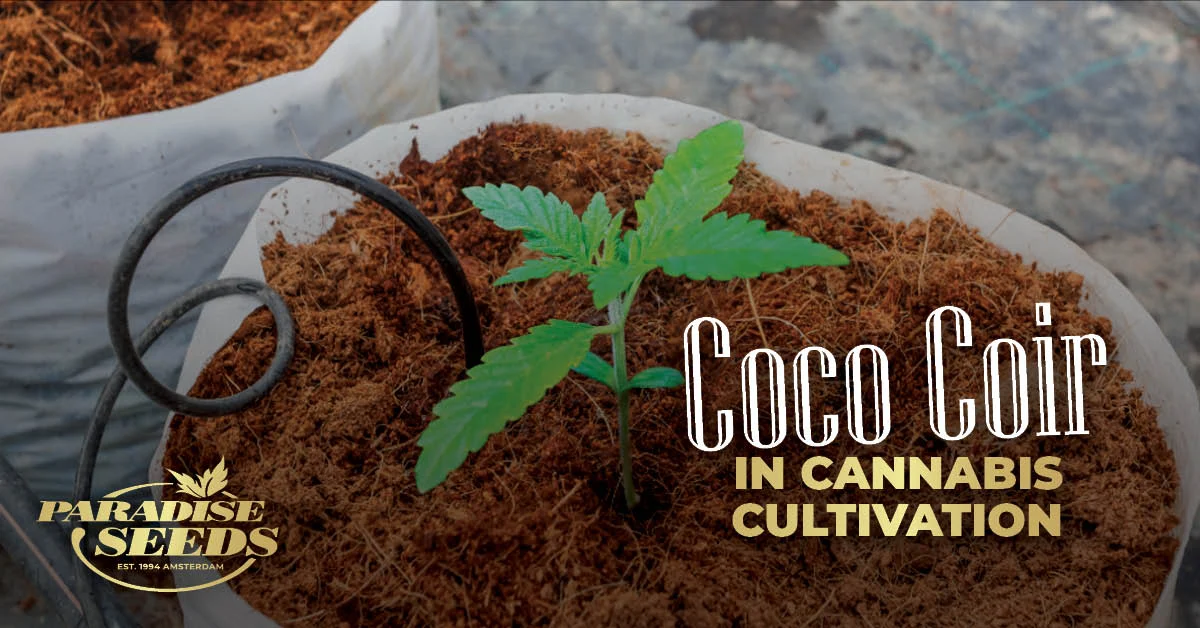In the last 5 years or so we have seen a particular growing medium gain a huge amount of traction in the world of cannabis cultivation – coco coir. It is a super productive substrate that is absolutely perfect for novice cultivators, as it provides a similar experience to soil growing while offering many of the advantages of hydro-based cultivation methods. Setting up a full hydroponic system can be slightly daunting, especially for first-timers but coco coir is a great substrate for new indoor growers to experiment with this method.
What Is Coco coir?
Sometimes also referred to as coco-peat, or just ‘coir’, Coco coir is made from the outer husks of coconuts, which have been shredded and pulverized. There are different grades available at a wide range of price points but for the best results, you should be looking for a nice, fine mix without any signs of large chunks or other debris.
It is sold in a couple of different forms, usually either as a compressed brick or in bags that closely resemble everyday potting mix. All of the larger reputable cannabis nutrient companies have their own proprietary Coco coir blends available. If you decide to go with a cheaper compressed block, make sure to give it a good wash through before planting (as some may carry nutrient traces that are harmful for cannabis seedlings).
The Benefits Of Coco coir in Cannabis Cultivation
Coco coir offers a few advantages over pure soil or hydro cultivation methods, for both novice and experienced growers alike.
- High air to water ratio – One of the biggest advantages of Coco coir, especially when it is mixed with perlite, is the oxygenation capabilities of the medium. With soil-based cultivation, the root zone can become deprived of oxygen if the medium is overwatered. Coco coir is able to keep a healthy level of oxygenation even when it is totally saturated, and when watered correctly it can offer up to 70% more oxygen to the root zone than pure soil.
- High natural resistance to pests and disease – Growers using Coco coir as their main medium for cultivating cannabis will find that they will have fewer problems with bugs and disease, and the chances of mold issues are heavily reduced.
- Fully inert – Coco coir is a perfect hydroponic medium as it comes totally inert and with a neutral pH value. This allows for full control over the nutrients that are supplied to the crop.
- More vigorous growth – When compared to soil cultivation, Coco coir offers far better rates of cannabis plant growth. This is due to being able to quickly deliver all needed nutrients in an extremely accessible form with higher oxygen levels
- Easy to flush – If you run into any nutrient issues, Coco coir is much easier to flush than soil-based methods. This heavily boosts the chances of a crop surviving such problems and makes the final flush much quicker.
- Great for the environment – Coco coir is a fully sustainable product, and can be used for multiple crops as long as it is properly washed between runs.
How To Grow Cannabis With Coco coir
There are a bunch of different ways you can implement the use of Coco coir for weed cultivation, but let’s focus on the most commonly used method for beginners. Again, all of the large nutrient producers will have a dedicated range of nutes specifically designed for use with Coco coir.
- Fill a pot with your Coco coir mix, make a small inch or so deep indentation in the middle, and drop one of the germinated seeds in. Cover it over lightly and give it a careful, light watering.
- Once you see the first set of true leaves, it’s time to feed! Some growers recommend cutting nutrient doses by at least half for the first few weeks and keeping a close eye on the growth. If you see any over-feeding issues arising, give the crop a good flush and drop the EC levels right down. It’s important to always keep the pH level between 5.5 and 6.5 for Coco coir cultivation.
- Growing cannabis with Coco coir is not only easy and forgiving (which really does make it absolutely perfect for beginner cultivators), it also offers you the chance of getting the very best final product. Always remember to cure those buds after the drying period is finished for the tastiest, stickiest, dankest results.
Good luck, and happy harvesting!



